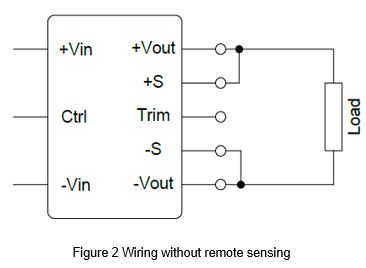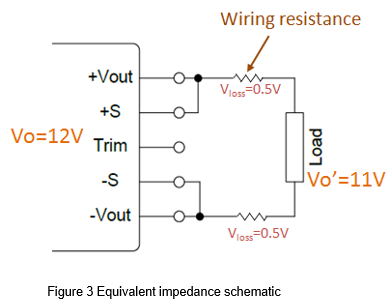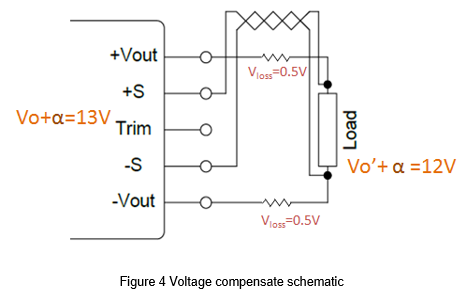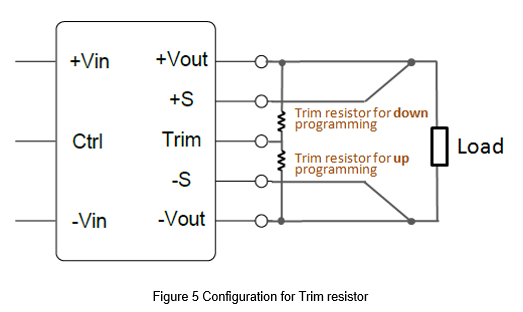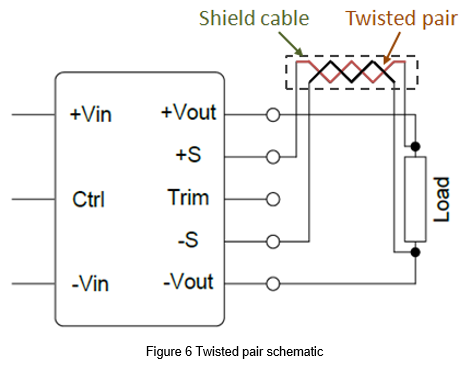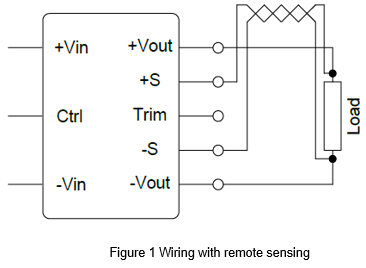
You are here
Back to topWhen will you need remote sensing?
Some DC-DC converters are equipped with a remote voltage sensing function. The main purpose of function is that compensate the voltage drop caused by the distance between the output and the load. The remote sensing function can directly detect the voltage at the load to overcome the power loss caused by the wires or connection points.
What situation does remote sensing seem important? It depends on your application. For example, the impedance of line is 0.1Ω and the load current is 1A, the voltage drop will be 0.1V caused by the line impedance. If the voltage accuracy required 5% for general products have 5V output, you won’t need to pay attention. However, if the voltage accuracy is required 1%, you must be taken wire loss into account.
Application and Reminder
Basic configuration
Power converters with remote sensing function usually have +Sense and -Sense pins, which are abbreviated as +S and -S in the figure. If you need to use the remote sensing function, you should connect the +Sense and -Sense pins to the positive and negative terminals of the load respectively, as shown in Figure 1. This function allows the converter to detect the voltage across the load without being disturbed by the impedance of the wires. If there is no need to use this function, just connect to the positive and negative terminals of the converter respectively, as shown in Figure 2.
The technology of remote sensing
The technology of remote sensing detected the voltage at the load and compared with the output voltage of the power converter. If there was found voltage drop, the output voltage would increase to compensate the voltage drop due to the line impedance.
Assume that the nominal output voltage of the converter is 12V, and the voltage drop is 0.5V occurred across each wire. So the voltage at the load terminal is 11V (Figure 3). After connecting the sense line, the converter output voltage will increase to 13V, and the voltage at the load terminal will be adjust to 12V, which can meet the nominal output voltage value (Figure 4).
The Load Voltage
The load voltage is the voltage detected at the load. Between the converter output and the load input, there is an unavoidable voltage drop due to the impedance of the wires. The conditions that affect the load voltage depend on the amount of load current and the size and length of the load wires. Therefore, low-voltage products must pay more attention to the output voltage drop. Generally, low-voltage products require more current to operate. When the load is placed far away from the product, it may cause serious output power loss. It is recommended that such products use the remote sensing function to compensate for the voltage lost through the wires.
Remote Sensing and Trim function
The remote sensing and Trim function can be used at the same time. The connection of the voltage trim resistor is shown in Figure 5. To connect the resistor to the Trim and -Vout pins for trim up. To connect the resistor to the Trim and + Vout pins for trim down. Please refer to the product specifications for the parameters of the Trim resistor.
When remote sensing and Trim up function is used, the output voltage will be adjusted to higher than the nominal voltage. For example, the 12V nominal output would be adjusted to 12.5V. It must be noted that the output voltage of the power converter may exceed the allowable upper voltage limit and accidentally trigger the OVP then shut down the converter. Therefore, please read the product specifications to understand the product's voltage adjustable range and OVP point to ensure the normal operation of the product.
Note that Trim Up and Trim Down cannot be used simultaneously. And the power cannot over the upper limit with using trim up. For example, there is a 60W power converter and the output voltage is 12V. And the output current is 5A at full load. When trim up increases the output voltage by 10% to 13.2V, the output current must be reduced to 4.5A to maintain the output power of 60W.
Remote Sense Line connecting
In some applications, the remote sensing function is not used. In this case, +Sense and -Sense should not be left open to avoid voltage floating. It is recommended that +Sense and -Sense are connected to +Vout and -Vout respectively. For the connection method, please refer to Figure 2.
Remote Sense Line twisted pair
The Sense wire is not the main path of the system and carries very little current. It is recommended to use twisted wires for the +Sense and -Sense wires or shielded cable to avoid noise and unwanted inductance. And use different color sensing lines to make it easy to distinguish +Sense and -Sense after winding (Figure 6).
Summary
The remote sensing will directly compensate the voltage lost by the wire. When the requirement of accuracy of the output voltage is high or the load is far away, this function may be required. Although the remote sensing function is convenient and effective, it is easy to exceed the usage limit in practical applications. This article provides suggestions and precautions for user. And please read the product specifications to understand the voltage compensation range of each product and the maximum power to avoid exceeding the range that the product can withstand. All for ensure the product in the best condition.
CTC is a professional service provider for high-end power supply modules (AC to DC Converter and DC to DC Converter) for critical applications worldwide since 30 years. Our core competence is to design and deliver products with leading technologies, competitive pricing, extremely flexible lead-time, global technical service and high-quality manufacturing (Made In Taiwan).
CTC is the only corporation certificated with ISO-9001, IATF-16949, ISO22613(IRIS), and ESD/ANSI-2020. We can 100% ensure not only the product, but also our workflow and service to match quality management system for every high-end application from the very beginning. From design to manufacturing and technical support, every single detail is operated under highest standard.


